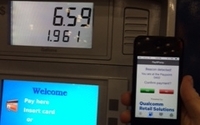 Multi-screen mobile commerce is starting to blend with targeted
advertising at the gas pump.
Multi-screen mobile commerce is starting to blend with targeted
advertising at the gas pump.
At the National Retail Federation Expo this week, I visited with a gas pump manufacturer that demonstrated the gas pump of future, replete with embedded Bluetooth
technology to identify customers as they approach the pump.
Commerce at the gas pump is hardly new, as motorists have for many years pumped their gas then paid by credit card at the pump or
cash in the nearby kiosk or store.
And the idea of a gas pump recognizing you as you approach the pump also is hardly a new concept.
However, what is novel here is the very tight
integration of mobile commerce and targeted advertising with the gas pumping activity by the available and stationary consumer.
And this is not from a mobile startup but from Gilbarco
Veeder-Root, the world’s largest manufacturer of gas pumps, point of sale systems and other gas station equipment.
Earlier this week, Gilbarco announced that it bought Outcast Media,
which operates a network of digital video displays in gas pumps.
The pump I saw at the NRF show had Qualcomm’s Gimbal proximity beacon installed in the pump, which can recognize
approaching phones of customers who have opted in to the program.
As the consumer approaches, payment options are offered on the consumer’s smartphone, where the transaction originates
rather than at the pump.
As the consumer pumps, targeted commercials play on the pump screen, with associated offers sent to the phone.
The smartphone and pump screen messaging is
based on information such as from a loyalty program, and could include name, location, gender and associated loyalty behavior, according to Parker Burke, director of marketing, payment and media
solutions, who showed me the system at the show.
Gilbarco has a base of about 60,000 gas stations and the Outcast network reaches more than 20,000 screens.
The messaging can include
instant and stored smartphone coupons based on the pump commercials in hopes of driving more customers into the gas station stores, much more profitable than the gas.
At the end of the
pumping, the consumer completes the purchase via smartphone.
You can expect to see these pumps showing up in the first half of this year, says Burke.
Paying at the pump is about to
become more mobile.